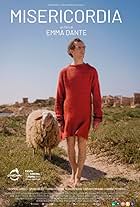IMDb RATING
6.5/10
1.6K
YOUR RATING
Maria, Pinuccia, Lia, Katia and Antonella are five sisters who live in an apartment in Palermo. When Antonella accidentally dies, the sisters' relationships are turned upside down for the re... Read allMaria, Pinuccia, Lia, Katia and Antonella are five sisters who live in an apartment in Palermo. When Antonella accidentally dies, the sisters' relationships are turned upside down for the rest of their lives.Maria, Pinuccia, Lia, Katia and Antonella are five sisters who live in an apartment in Palermo. When Antonella accidentally dies, the sisters' relationships are turned upside down for the rest of their lives.
- Awards
- 9 wins & 22 nominations
Bruno Di Chiara
- Marco
- (credit only)
Storyline
Did you know
Featured review
IN A NUTSHELL:
The Macaluso sisters are five orphaned siblings who live in and work from a shabby rooftop apartment in Palermo, Sicily. They make a living by renting out doves, which they paint festive colors, for weddings and funerals. A summer beach outing is planned on a rare day off from work. Near the close of a day full of enchantment, reverie, and close encounters with secret lovers, a shocking catastrophe transpires. That single event forever alters the family dynamic, challenging the delicate balance of sisterhood in this generation-spanning feature. The melancholy film is a remake of a very famous Italian stage play created by director Emma Dante.
THINGS I LIKED: The film premiered in competition at the 2020 Venice International Film Festival where it won the Pasinetti Awards, given by the National Union of Italian Journalists, for Best Film and Best Actress (awarded to the ensemble cast playing the sisters), and has since won the association's annual prizes for Best Film and Best Director.
The introduction is intriguing because you hear sounds but can't quite figure out what's happening. There is dialogue, yet the most evocative scenes are when no one is talking.
Twelve actresses play the five sisters over the years. Look for the little details that will help you determine which sister is which as they age. The aging of the sisters who carry painful memories of another sister's death is haunting.
The theme song is very sweet and melancholy.
In fact, all of the sounds are mesmerizing.
The color palette seemed bright when the sisters were young, but then it takes on muted shades as they age. It made me wish I could spend more time in Act 1 with the youth. Don't we all wish we could spend more time in our youth, knowing what we now know?
It's interesting to watch the evolution of various scenes that take place in the bathtub.
The film is full of symbolism, making the movie much richer. To better understand and appreciate the movie, I'm including these helpful notes from the director: The main character of the film is the whole of the five sisters that, from the beginning to the end of both film and life, acts as an organism apart with its own rules, bonds, and voice. Each sister is like a vital organ, indispensable to this entity that combines each peculiarity and harmonizes them by melting them into a compact, vibrating nucleus. The emotional fibers that bond these five women into a single character are so strong that, even though they fall apart, they never go away: in fact, not even death can erase the presence of one of the bodies belonging to this nucleus, and it doesn't even reduce the vital strength of this whole.
MARIA (brain) She's the first-born. When the story begins, she's eighteen years old. She takes care of her sisters. For this reason, she can be described as the brain of this organism: she represents the rational part of the group and is the one who makes decisions, so she's the voice everybody listens to. A voice that calms down, for it gives protection; it inspires, it knows.
PINUCCIA (skin) Pinuccia is the second-born. She carries the weight of authority without being authorized, and regulates conflict through conflict, love through love. Like it or not, she's the one who takes care of the most complicated sister, Lia. She's the skin of the family: a thin organ, yet very strong. It's the first defense and shows the distress of the organism more than the other ones; Pinuccia often communicates her pain without stepping back. She represents sex and the sensual part of the Macaluso sisters.
LIA (heart) Lia is guided by instinct and passion. On an age and geographical level, she's placed at the center of the organism. Often it's her inputs that move it, just like the heart in the human body. The rhythm of her heartbeat articulates the mood of the whole, declares its tiredness or its vitality, its calmness or its euphoria, its passivity or its aggressiveness. She's the sister who bonds the group in a stronger way, but at the same time, she distinguishes herself, just like a human heart, which is an involuntary muscle.
KATIA (stomach) We first meet her when she's twelve and chubby, a sandwich in her hand, and see her again in her seventies, with her own family who supports her. It's as if she were the stomach of this nucleus, for it looks like she's been able to digest all of life's obstacles and assimilate its nutrients. She ends the cycle that opens the film; a virtuous cycle that leads her to carry on with her life beyond the exclusive nucleus of her sisters.
ANTONELLA (lungs) She's the baby of the family. Her presence is the breath that gives air to the whole story and never fades away. It represents hope, resistance, the lungs' habit of acting spontaneously, yet hardly; it's déjà-vu, an order broken by a loud cough, a gust of wind that immediately gathers itself up, yet into a different shape, hardly perceptible.
THE ORGANLESS CHARACTER: THE HOUSE There's the last character that goes through this story, the years, and the generations, all the changes, and the evolutions; it's physically inanimate, yet very intense. It's the house in which the five sisters have always lived and will always live; it experiences their ages and their changes, their joy, and their pain. It grows and breathes with them, scratches with them, gets dressed and undressed, and evolves with its residents, but, most of all, it observes them. The house perspective is the stare on the sisters, able to perceive any change or metamorphosis, but severely demure and sincere in its persisting silence, in the way it denies a judgment.
THINGS I DIDN'T LIKE: Some people simply don't like foreign films because reading the subtitles takes effort.
This is one of those "artsy-fartsy" indie films without a lot of action or dialogue.
Some viewers will be confused by the timeline and change of actresses.
Some scenes last way too long to make their point.
It's very sad and depressing. This will not be everyone's cup of tea.
TIPS FOR PARENTS: Kids will be extremely bored. So will some adults.
The entire film has subtitles because Italian is spoken.
Profanity and crude language in Italian (which is translated) Full-on female frontal nudity. You also see two topless women and a topless young girl.
Lesbians kiss You hear unmarried teens "doing it".
You see someone cut up a dead animal with lots of blood.
THEMES: Changes over time. Like the waves of the ocean, things and people come and go.
Memory Guilt Things that endure Age Life and death Family Sisterhood The influence we have on others
l!
THINGS I LIKED: The film premiered in competition at the 2020 Venice International Film Festival where it won the Pasinetti Awards, given by the National Union of Italian Journalists, for Best Film and Best Actress (awarded to the ensemble cast playing the sisters), and has since won the association's annual prizes for Best Film and Best Director.
The introduction is intriguing because you hear sounds but can't quite figure out what's happening. There is dialogue, yet the most evocative scenes are when no one is talking.
Twelve actresses play the five sisters over the years. Look for the little details that will help you determine which sister is which as they age. The aging of the sisters who carry painful memories of another sister's death is haunting.
The theme song is very sweet and melancholy.
In fact, all of the sounds are mesmerizing.
The color palette seemed bright when the sisters were young, but then it takes on muted shades as they age. It made me wish I could spend more time in Act 1 with the youth. Don't we all wish we could spend more time in our youth, knowing what we now know?
It's interesting to watch the evolution of various scenes that take place in the bathtub.
The film is full of symbolism, making the movie much richer. To better understand and appreciate the movie, I'm including these helpful notes from the director: The main character of the film is the whole of the five sisters that, from the beginning to the end of both film and life, acts as an organism apart with its own rules, bonds, and voice. Each sister is like a vital organ, indispensable to this entity that combines each peculiarity and harmonizes them by melting them into a compact, vibrating nucleus. The emotional fibers that bond these five women into a single character are so strong that, even though they fall apart, they never go away: in fact, not even death can erase the presence of one of the bodies belonging to this nucleus, and it doesn't even reduce the vital strength of this whole.
MARIA (brain) She's the first-born. When the story begins, she's eighteen years old. She takes care of her sisters. For this reason, she can be described as the brain of this organism: she represents the rational part of the group and is the one who makes decisions, so she's the voice everybody listens to. A voice that calms down, for it gives protection; it inspires, it knows.
PINUCCIA (skin) Pinuccia is the second-born. She carries the weight of authority without being authorized, and regulates conflict through conflict, love through love. Like it or not, she's the one who takes care of the most complicated sister, Lia. She's the skin of the family: a thin organ, yet very strong. It's the first defense and shows the distress of the organism more than the other ones; Pinuccia often communicates her pain without stepping back. She represents sex and the sensual part of the Macaluso sisters.
LIA (heart) Lia is guided by instinct and passion. On an age and geographical level, she's placed at the center of the organism. Often it's her inputs that move it, just like the heart in the human body. The rhythm of her heartbeat articulates the mood of the whole, declares its tiredness or its vitality, its calmness or its euphoria, its passivity or its aggressiveness. She's the sister who bonds the group in a stronger way, but at the same time, she distinguishes herself, just like a human heart, which is an involuntary muscle.
KATIA (stomach) We first meet her when she's twelve and chubby, a sandwich in her hand, and see her again in her seventies, with her own family who supports her. It's as if she were the stomach of this nucleus, for it looks like she's been able to digest all of life's obstacles and assimilate its nutrients. She ends the cycle that opens the film; a virtuous cycle that leads her to carry on with her life beyond the exclusive nucleus of her sisters.
ANTONELLA (lungs) She's the baby of the family. Her presence is the breath that gives air to the whole story and never fades away. It represents hope, resistance, the lungs' habit of acting spontaneously, yet hardly; it's déjà-vu, an order broken by a loud cough, a gust of wind that immediately gathers itself up, yet into a different shape, hardly perceptible.
THE ORGANLESS CHARACTER: THE HOUSE There's the last character that goes through this story, the years, and the generations, all the changes, and the evolutions; it's physically inanimate, yet very intense. It's the house in which the five sisters have always lived and will always live; it experiences their ages and their changes, their joy, and their pain. It grows and breathes with them, scratches with them, gets dressed and undressed, and evolves with its residents, but, most of all, it observes them. The house perspective is the stare on the sisters, able to perceive any change or metamorphosis, but severely demure and sincere in its persisting silence, in the way it denies a judgment.
THINGS I DIDN'T LIKE: Some people simply don't like foreign films because reading the subtitles takes effort.
This is one of those "artsy-fartsy" indie films without a lot of action or dialogue.
Some viewers will be confused by the timeline and change of actresses.
Some scenes last way too long to make their point.
It's very sad and depressing. This will not be everyone's cup of tea.
TIPS FOR PARENTS: Kids will be extremely bored. So will some adults.
The entire film has subtitles because Italian is spoken.
Profanity and crude language in Italian (which is translated) Full-on female frontal nudity. You also see two topless women and a topless young girl.
Lesbians kiss You hear unmarried teens "doing it".
You see someone cut up a dead animal with lots of blood.
THEMES: Changes over time. Like the waves of the ocean, things and people come and go.
Memory Guilt Things that endure Age Life and death Family Sisterhood The influence we have on others
l!
- trinaboice
- Jul 31, 2021
- Permalink
- How long is The Macaluso Sisters?Powered by Alexa
Details
Box office
- Gross worldwide
- $639,760
- Runtime1 hour 29 minutes
- Color
Contribute to this page
Suggest an edit or add missing content






















